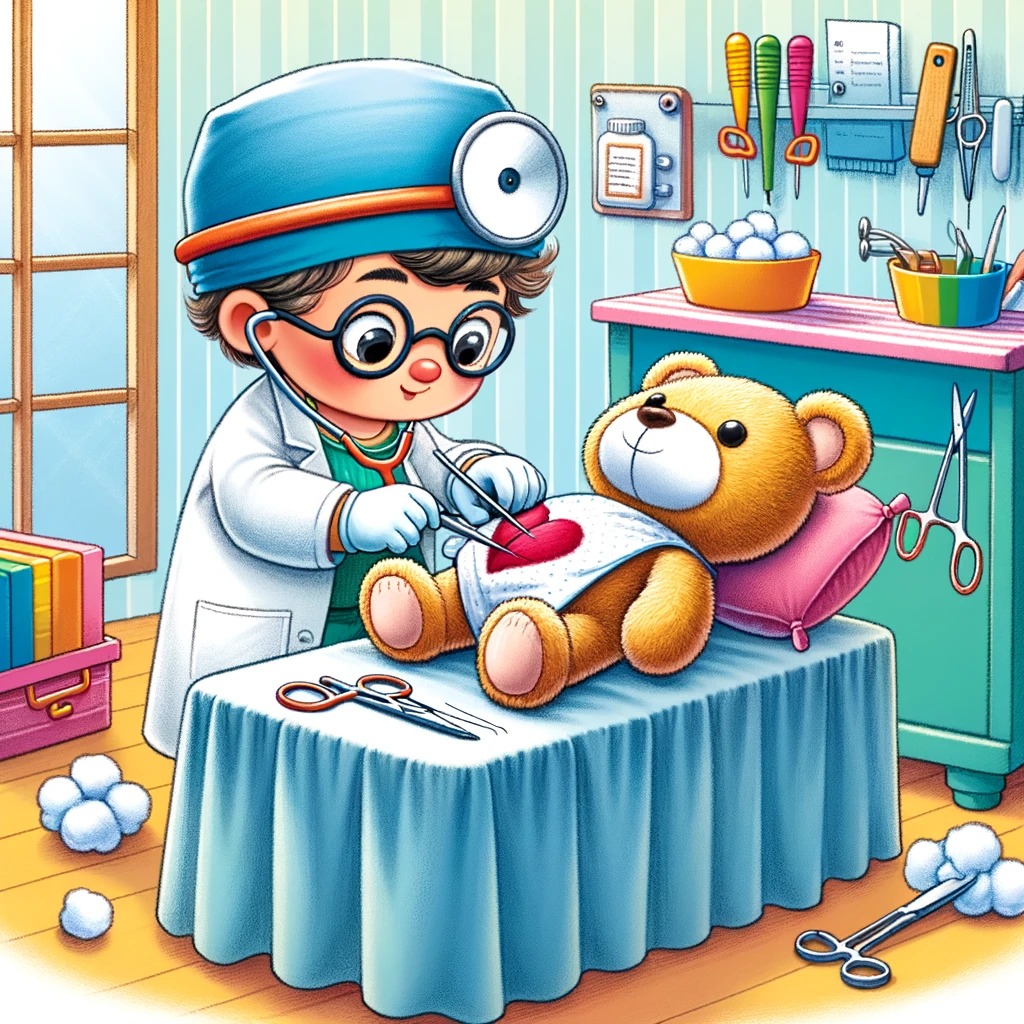Is your beloved teddy bear looking a little worse for wear? Does it seem lethargic, hollow chested, and in need of some TLC? If so, it may be time to perform the delicate, complicated, and not at all advisable procedure of open heart surgery on your stuffed companion. Follow this step-by-step guide to breathe new life (or at least new stuffing) into your fuzzy friend.
Step 1: Gather Your Supplies
Before diving scalpel-first into teddy bear surgery, make sure you have all the necessary tools on hand:
- A sharp knife or scissors (for the discerning stuffed animal surgeon)
- A needle and thread
- Replacement stuffing (cotton balls, polyester fiberfill, or the fluff from a spare pillow)
- Tweezers
- A stethoscope (optional, but it makes you look legit)
- Latex gloves (to prevent leaving fingerprints at the scene)
- A tiny teddy sized hospital gown (have some respect for your patient’s dignity)
Step 2: Sterilize Your Tools
In a real operating room, it’s critical that all surgical instruments are properly sterilized to prevent infection. When it comes to operating on a teddy bear, this step is…well, still kind of important, we guess? Give your knife or scissors a quick wipe with some rubbing alcohol or soap and water. Your fluffy patient doesn’t need you introducing any new microscopic friends into their cotton-filled cavities.
Step 3: Administer Anesthesia
Now, we know what you’re thinking: “Isn’t my teddy bear already inanimate? Do I really need to put it under anesthesia?” The answer is a resounding yes! Not because it’s medically necessary, but because it’s fun to pretend. Here are some creative ways to anesthetize your plush pal:
- Place a tiny mask over its snout and make a “hissssss” sound to simulate gas anesthesia
- Pretend to give it an IV drip using a piece of string and a bottle of honey
- Just say “Shhh, go to sleep now” and trust that your teddy bear is a good listener
Step 4: Make the Incision
Time to put your steady hands to the test! Carefully make an incision on your teddy bear’s chest, right where you imagine its heart would be. Use your knife or scissors to cut through the outer fabric and into the stuffing. Try not to let the stuffing spill out too much – you don’t want your operating room to look like the aftermath of a pillow fight.
Step 5: Perform the “Heart Transplant”
Now that you’ve accessed your teddy bear’s “heart,” it’s time to get in there and do some serious doctoring. Use your tweezers to remove any old, lumpy stuffing that’s past its prime. Make sure you get all the nooks and crannies – you don’t want your teddy bear’s chest cavity to be a breeding ground for dust bunnies.
Once you’ve cleared out the old stuffing, it’s time to give your teddy bear a “heart transplant” by stuffing it with fresh, fluffy filling. Use your needle and thread to sew any holes or tears in the fabric, then fill ‘er up with your stuffing of choice. Don’t be shy – your teddy bear deserves a plump, cuddly chest!
Step 6: Close Up and Admire Your Handiwork
Congratulations, you’ve successfully completed open heart surgery on your teddy bear! Give yourself a pat on the back – you’ve earned it. Use your needle and thread to sew up the incision, making sure to keep the stitches neat and tidy. You don’t want your teddy bear looking like Frankenstein’s monster (unless that’s the look you’re going for, in which case, you do you).
Take a step back and admire your work. Your teddy bear should be looking refreshed, rejuvenated, and ready to take on the world. Give it a big hug and let it know that it was a trooper throughout the whole procedure.
Post-Op Care: Helping Your Teddy Bear Recover
Just like with any major surgery, your teddy bear will need some time to recover from its ordeal. Here are some tips for post-op care:
- Keep your teddy bear in a clean, dry place to prevent infection. A shoebox lined with a soft blanket makes a perfect teddy bear recovery room.
- Give your teddy bear plenty of rest. No rough play or wild tea parties for at least a week.
- Provide emotional support. Your teddy bear has been through a lot, so make sure to give it extra cuddles and words of encouragement.
- Monitor for any signs of complications. If your teddy bear starts leaking stuffing, develops a strange odor, or begins to talk back to you, seek professional help immediately.
Frequently Asked Questions About Teddy Bear Surgery
Q: Can I perform this surgery on other stuffed animals besides teddy bears? A: Absolutely! The principles of stuffed animal surgery can be applied to all manner of plush pals, from bunnies to dinosaurs. Just adjust your technique based on the size and shape of the patient.
Q: What if I don’t have any replacement stuffing on hand? A: In a pinch, you can use tissues, cotton balls, or even shredded paper to re-stuff your teddy bear. Just make sure whatever you use is clean and dry.
Q: Is it normal for my teddy bear to look a little…different after surgery? A: It’s common for teddy bears to experience some changes in appearance after undergoing surgery. They may have a slightly lumpier tummy, a crooked smile, or a faraway look in their eyes. These are all normal side effects and should resolve with time and love.
Q: Can I perform this surgery on a human? A: NO. Absolutely not. This guide is for teddy bears and other stuffed animals ONLY. Performing any kind of surgery on a human without proper training and credentials is extremely dangerous and illegal. Stick to the plushies, folks.
Conclusion
Well, there you have it – a comprehensive guide to performing open heart surgery on your teddy bear. We hope you found this tutorial both informative and entertaining, and that your teddy bear is now living its best, fluffiest life.
Remember, stuffed animal surgery is a delicate art that requires patience, skill, and a healthy dose of imagination. But with a little practice (and a lot of googly eyes), you too can become a master of the craft.
Happy operating, teddy bear surgeons! May your stitches be straight, your stuffing be plentiful, and your patients always make a full recovery.
Recent Posts
Times Square, the beating heart of New York City, is like a giant disco ball that never stops spinning. It's a place where the neon lights are so bright, you'll need sunglasses at midnight. The...
In a world where water is becoming scarcer than a unicorn's tears, organic farmers are taking matters into their own hands. They're ditching the old-school methods of drowning crops in a deluge of...

